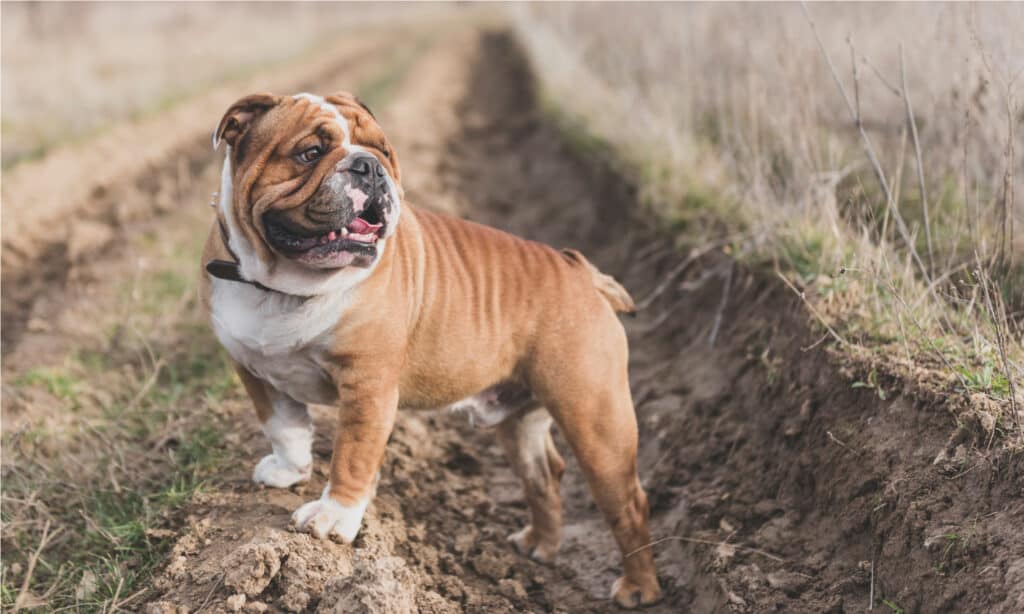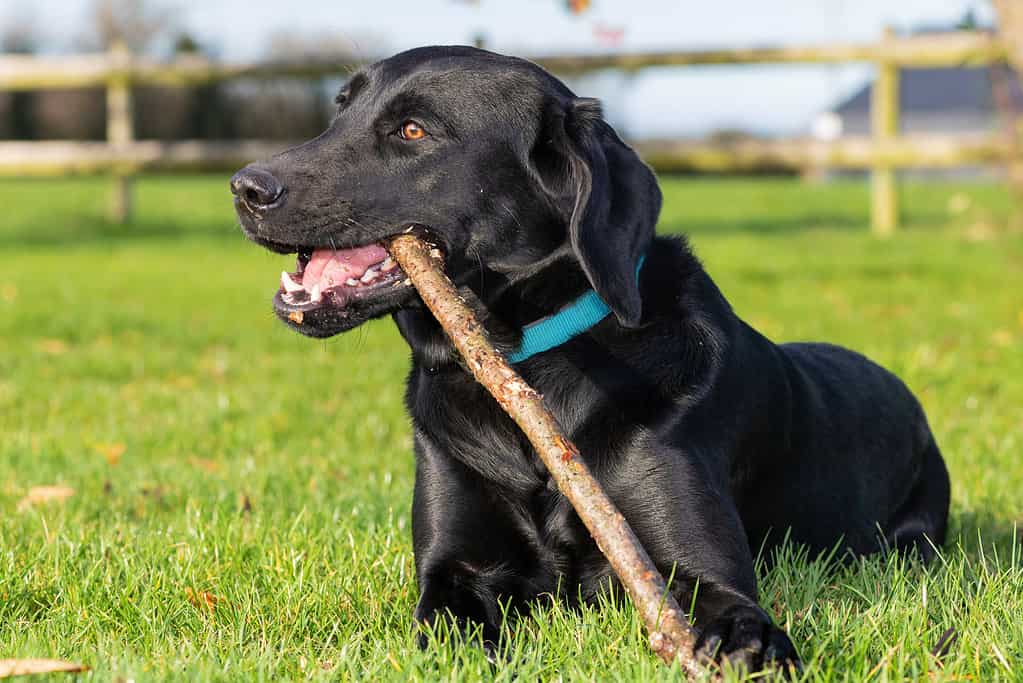Labrador retrievers and bulldogs are some of the most popular dog breeds in America and worldwide. The Labrador retriever, also known colloquially as Labrador or Lab, is an ultra-lovable family dog popular for its friendly and outgoing nature. These highly active dogs are adored for their gentle demeanor, work ethic, and playful personality.
Bulldogs are short, stocky, medium-sized dogs popular for their calm demeanor. The wrinkly, smiling faces give them a distinctive appearance. Most pet parents fall in love with their sweet and easygoing temperaments.
The two dog breeds differ in numerous ways, including their physical appearance, origin, temperament, energy requirements, and maintenance needs, among other parameters. Read on to learn about the differences and similarities that make these two popular breeds unique.
Key Differences Between Labrador Retriever vs. Bulldog
| Comparison | Labrador Retriever | Bulldog |
|---|---|---|
| Height | 21.5 to 24.5 inches | 14 to 15 inches |
| Weight | 55 to 80 pounds | 40 to 50 pounds |
| Coat type | Short, dense, waterproof double coat | Short, smooth coat |
| Coat colors | Black, yellow, chocolate | fawn, white, brindle, red, and gray. |
| Temperament | Friendly, cheerful, energetic, athletic, intelligent | Affectionate, courageous, stubborn, loyal, protective |
| Life expectancy | 11 to 13 years | 8 to 10 years |
| Grooming needs | Seasonal shedding requiring regular brushing | Minimal shedding requiring occasional brushing |
| Child and stranger friendliness | Great adaptability to fit most social interactions | Friendly and gentle but may present protective behaviors |
| Price | $1000 to $ 2,000 | $800 to $ 4,000 |
| Energy and social needs | Highly energetic, very playful, requiring lots of mental stimulation | Moderately active, less enthusiastic, requiring less exercise and playtime |

Bulldogs are friendly and gentle, although may present protective tendencies.
©ltummy/Shutterstock.com
Breed Backgrounds
Labrador retrievers originated in the Canadian province of Newfoundland. The dogs were initially bred to assist fishermen and retrieve games for the early European settlers. Their short denser water-resistant coat and foot webbing made them excellent swimmers, appealing to the fishing communities.
The kind, gentle nature of the modern bulldog often contrasts with its predecessors from which it was bred. The history of the bulldog can be traced back to fifth-century England, from a breed identified as the Alaunt. A few centuries later, the dog was popularly used by butchers and farmers to control livestock.
The modern bulldog is bred from the Old English bulldog, a short, strong, aggressive breed used in bull-baiting–fights pitting dogs against tethered bulls. With the banning of the brutal game in 1835, breeders re-engineered the dog, infusing a patient and friendly temperament and fierce loyalty to their owner.
Appearance
Families may need to understand the exact size of their preferred breed before bringing them home, especially if they require accommodation adjustments. Fortunately, bulldogs and labradors are greatly-sized dogs that would fit in most homes. Here’s a comparison breakdown based on physical appearance.

Bulldogs and Labradors are great options as they fit well in most homes.
©Judal/Shutterstock.com
Labrador Retriever Vs. Bulldog: Height And Weight
Labrador retrievers are medium-sized to large, sporty dogs with an athletic and muscular build. Male Labradors weigh 55-80 pounds, with females being ten to fifteen pounds lighter. These dogs have an average height of 21.5 to 24.5 inches at the shoulder. The average male Lab is 67.5 pounds with a shoulder height of 23 inches, while the average female is 62.5 pounds and 22 inches tall.
Bulldogs, on the other hand, are smaller than the Labrador retrievers. They have a short, sturdy, and compact body structure, reflected in their energy levels. Mature bulldogs weigh between 40-50 pounds. Males are typically heavier. All adult bulldogs, regardless of gender, are about 14 to 15 inches tall.
Labrador Retriever vs. Bulldog: Coat Type And Colors
Labrador retrievers have dense, short to medium-length, double coats. The short and thick undercoat protects them from extreme temperatures. The outer coat is hard, dense, and waterproof. As a consummate water dog, the Lab has webbed toes that help them move through the water.
Labradors are born with different coat colors, including black, chocolate, or yellow. The silver Labrador retriever has a rarer greyish coloring. Labradors are medium to heavy shedders, and like every dog breed with a double coat, they require two to three times weekly brushing.
Bulldogs typically have short and smooth coats. The coat colors are majorly fawn, white, red, brindle, or grey. The ears and eyes also come in a variety of colors. The nose tip and lips are often black. Bulldogs shed less fur than Labrador retrievers and are easier to maintain.

Bulldogs have a sturdy, compact structure, broad chests, and thick bones.
©Pleple2000, CC BY-SA 3.0 via Wikimedia Commons – License
Labrador Retriever vs. Bulldog: Body Structure And Build
The Labrador retriever has a strong athletic build, one of its defining characteristics. This body structure is well-suited for various physical activities, explaining the breed’s success as a sporting dog. The athletic build enables Labs to excel in activities such as swimming and retrieving and participate in dog sports like agility competitions.
Bulldogs have a sturdy, compact structure, broad chests, and thick bones. This unique body build helps maintain stability and balance, keeping them more grounded. However, they are not built for intense physical activity, an issue worsened by their brachycephalic (short-muzzled) face.
Temperament And Personality Contrasts
A dog breed’s suitability and compatibility with your family largely depend on its temperament and personality. For example, the Labrador retriever is known for being highly energetic and would require a family with an active lifestyle. Bulldogs have a more laid-back demeanor. Understanding temperaments and personality contrasts can help you find the perfect breed to match your lifestyle.
Labrador Retriever vs. Bulldog: Energy Levels And Exercise Needs
Labrador retrievers are popular for their high energy levels and innate enthusiasm, especially when young. Families that plan to adopt a Lab must maintain an active lifestyle to keep the dog happy and healthy. Labradors that don’t get enough exercise engage in hyperactive or distractive behavior to release pent-up energy.
The breed excels in jogging, long walks, swimming, and retrieving activities. You can also keep your dog active by enrolling them in canine sports such as agility, tracking, obedience, hunting, and dock diving.
Bulldogs, conversely, have much lower energy levels than Labradors. They are happy to relax and cuddle next to your feet. The breed requires moderate exercise, and occasional walks can help meet this requirement and keep them healthy.
Owners can also include mental stimulation exercises such as interactive play and training sessions. You may need to be careful not to overexert your bulldog due to its short-muzzled face, making breathing and temperature regulation difficult.

Labrador retrievers are high-energy animals that require an active lifestyle.
©iStock.com/Strelciuc Dumitru
Labrador Retriever vs. Bulldog: Trainability And Intelligence
Labrador retrievers are widely regarded as highly trainable dogs. World-renowned canine psychologist, Stanley Coren, ranked Labradors seventh on his list of the ten most intelligent dogs. Labradors are in the top-tier of the dog breeds with the highest IQ. Their high IQ and eagerness to please their owners make them quick learners and easy to train.
Labradors can easily earn and follow basic commands and would fit a family searching for an affectionate dog that will readily learn commands, behaviors, and tricks. Consistent and reinforcement training works exceptionally well with Labs.
Bulldogs are inherently stubborn, a trait that may become prevalent during training sessions. In his book, The Intelligence of Dogs, Stanley Coren ranked bulldogs in the sixth tier, among the least effective dogs to train, requiring more than 100 repetitions.
Bulldogs are popular for being strong-willed and can sometimes be resistant or independent thinkers during training. Families may need to be patient and consistent in their training approach. Treat rewards and praise can help keep the bulldogs interested and more receptive to learning.
Labrador Retriever vs. Bulldog: Socialization And Compatibility With Other Pets
Labrador retrievers are generally pleasant and friendly. This calm demeanor extends to their interactions with humans and other pets. As such, Labs are excellent candidates for households with existing pets or plan to introduce new pets in the future. However, positive socialization training from an early age is ideal.
Bulldogs often form strong bonds with their human family members. In contrast, they may be more reserved or cautious around other animals, including dogs and pets. Proper socialization and positive reinforcement are necessary to help introduce your bulldog to co-exist peacefully with your other pets.
It’s essential to note that personality traits are unique to the individual. Some Labradors may display territorial or dominant behaviors, while other bulldogs may be more accepting and friendly. Monitoring your dog’s interactions can ensure the safety of all animals involved.

While they can be reserved around other animals, Bulldogs bring unwavering devotion to their loved ones.
©iStock.com/jesse757
Labrador Retriever vs. Bulldog: Behavior Around Children And Strangers
Labrador retrievers earn a well-deserved reputation for gentleness and patience around kids. Their friendly and tolerable nature makes them suitable companions for families with small children. Nonetheless, as with all interactions between dogs and kids, adult supervision is crucial to keep your children and pets safe.
Labradors are also great with strangers. They are often comfortable in new social settings. Labs will enthusiastically greet your visitors, making them a great dog breed in social functions. Proper socialization and training on acceptable behaviors and boundaries when meeting new people are vital.
Bulldogs tend to be affectionate around children. They typically maintain strong bonds with their human friends. Their calm and gentle nature makes them an excellent breed for families with kids. In contrast, bulldogs are often more conservative when meeting strangers. Their protective instincts and cautious nature means they may need some time before warming up to the visitors in your home.
Physical limitations and potential health issues can complicate the breed’s relationship with kids. Due to their unique body structure, bulldogs may not be as physically active to keep up with energetic children for extended periods. Adult supervision can help ensure the dogs aren’t overwhelmed by the tumble and play.
Labrador Retriever vs. Bulldog: Living Space Requirements
Labrador retrievers adjust well to various living spaces, including apartments, as long as their exercise requirements are met. Nonetheless, the breed particularly thrives in homes with access to outdoor areas. Labradors are highly energetic and respond positively to ample space to run, play, and fetch.
Bulldogs, on the other hand, are more adaptable to smaller living spaces. Their lower exercise requirements and calm demeanor make them ideal candidates for families living in apartments or tight urban homes. Despite living in small quarters, you must ensure that your bulldog receives the required level of exercise.

Labradors truly come alive in homes with outdoor access, where they can run, play, and enjoy endless adventures.
©iStock.com/Tom Meaker
Maintenance And Care
Maintenance and care are critical considerations when choosing a dog breed, as they directly impact the dog’s well-being and overall quality of life. Labradors typically have more grooming requirements compared to bulldogs. Here’s an in-depth look into both breeds’ maintenance and care.
Grooming Requirements
Labrador retrievers have moderate grooming requirements. Most of the work revolves around managing shedding. Shedding is seasonal, with the dogs requiring regular brushing to keep the fur healthy. Twice or thrice a week during the shedding season is more than enough to control fur loss.
Bulldogs have fine coats with minimal shedding. Occasional brushing can help eliminate loose hair. Pet parents, however, must pay close attention to their facial wrinkles. The skinfolds often trap dust, moisture, and dirt, resulting in irritation or infections. You can use a damp, wet cloth to clean the wrinkles, ensuring they are well-dried afterward.
Both breeds may require other grooming routines such as dental cleaning, nail trimming, and ear care. Regular grooming can help you identify potential health issues early and seek medical attention.
Lifespan, Health and Potential Breed-Specific Concerns
Labrador retrievers have an average lifespan of 11-13 years; they’re typically healthy dogs but are susceptible to specific conditions and ailments due to genetics. Common health conditions that affect Labradors include:
- Elbow and hip dysplasia
- Hereditary myopathy
- Epilepsy
- Tricuspid valve dysplasia
- Bloat
- Ear Infections
- Retinal atrophy
Bulldogs will live for approximately 8-10 years. Common health conditions that affect dogs are Brachycephalic Syndrome, cherry eye, respiratory diseases, and infections in the skin folds.
Pet parents of both dog breeds should ask their breeders to provide evidence of genetic checks for these specific conditions. DNA tests can help identify carriers and, through planned breeding, reduce the risk of producing the disease.

With an average lifespan of 8-10 years, bulldogs may be prone to certain health conditions, including Brachycephalic Syndrome and respiratory issues.
©Eric Isselee/Shutterstock.com
Feeding And Dietary Considerations
One of the profound differences between the two breeds is feeding. A two-month Labrador pup should consume approximately 200-250 grams of food. Puppies six months old and over should receive roughly 350 to 450 grams. Bulldog puppies don’t have any restrictions on feeding, with a general rule of thumb of three cup portions daily. After six months, you can cut back to one cup of high-quality dry dog food twice daily.
Adult labradors tend to overeat, and portion control is essential to prevent obesity. The dog should do well with high-quality food, whether commercially- or home-prepared.
As a bulldog parent, you need to be wary of legume-based food. Research suggests that there may be a link between legume-rich grain-free foods and Canine Dilated Cardiomyopathy, a condition that leads to heart failure in dogs. Don’t feed your bulldog legume-rich foods as it’s highly susceptible to heart failure. Luckily, pet parents can access numerous legume-free dog food brands for their pups.
Labrador Retriever vs. Bulldog: Price
The average price of a labrador purchased from a reputable breeder is between $1,000 to $2,000. Puppies with exceptional qualities and genetic history, such as athleticism, tend to fall on the higher end, around $1,800 to $2,000. The color of the Labrador retriever you prefer may also influence the final price. Chocolate Labs are rarer than black or yellow pups, making them more expensive.
Unlike Labradors, bulldog puppy prices vary significantly, from $800 to $4,000. The price may depend on the type of bulldog, the genetic history, and the color of the pup. A puppy from Champion parents or AKC purebred parents can go for as high as $10,000.

The average price of a labrador purchased from a reputable breeder is between $1,000 to $2,000.
©Anna Goroshnikova/Shutterstock.com
Choosing The Right Breed For Your Lifestyle
After an in-depth analysis of the Labrador retriever and bulldog breeds, it’s evident why both are exceptionally popular among dog lovers. Each has its unique characteristics that make them stand out. Labradors exhibit friendliness, gentleness, and liveliness, while bulldogs are sturdy, calm, and easily adapt to smaller living spaces.
Choosing between a Labrador or bulldog greatly depends on lifestyle preferences and the family’s ability to meet each breed’s necessities. Extensive research may be required, along with reaching out to reputable breeders and interacting with both species individually to determine which is better suited for your family.
The photo featured at the top of this post is ©
Ready to discover the top 10 cutest dog breeds in the entire world?
How about the fastest dogs, the largest dogs and those that are -- quite frankly -- just the kindest dogs on the planet? Each day, AZ Animals sends out lists just like this to our thousands of email subscribers. And the best part? It's FREE. Join today by entering your email below.
Thank you for reading! Have some feedback for us? Contact the AZ Animals editorial team.







